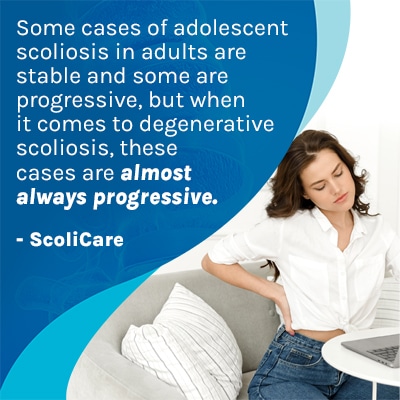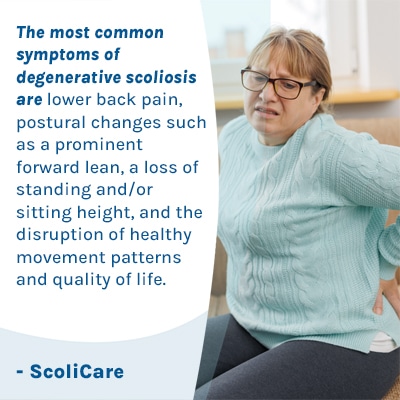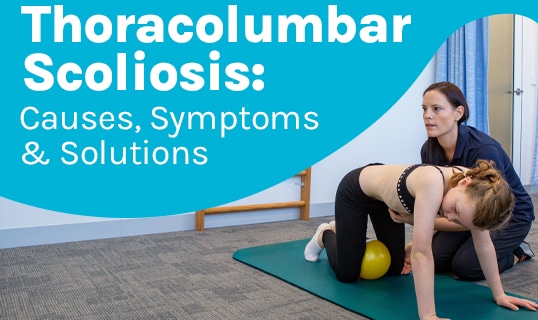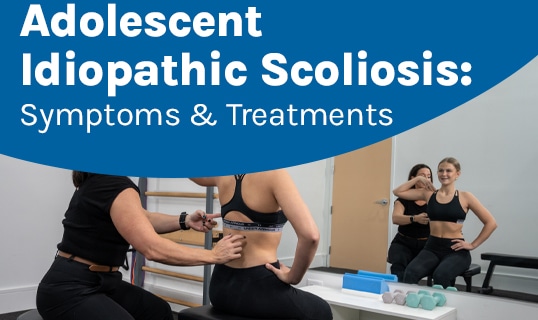Adult scoliosis can be pre-existing from adolescence, or develop in later adulthood with no prior history. Degenerative scoliosis is caused by age-related degeneration, and as the spine becomes increasingly unbalanced and unstable, the body is also affected, making it more vulnerable to injury.
Degenerative scoliosis is an unnatural lateral spinal curve that’s caused by degenerative instability. Degenerative scoliosis affects older adults and is caused by degenerative changes in the spine. Symptoms include pain, posture and movement changes. Treatment focuses on pain relief and fall prevention.
For those who develop scoliosis later in life, it’s almost always progressive and painful, but a proactive treatment plan can help.
Adult Scoliosis
When it comes to scoliosis, most of the focus is on childhood scoliosis. School-aged children are commonly affected by scoliosis, and it’s most often diagnosed during adolescence (1).
The most prevalent type of scoliosis overall is adolescent idiopathic scoliosis, typically diagnosed around 12 years of age, and it’s estimated that up to 5 percent of children between the ages of 10 and 18 will develop adolescent idiopathic scoliosis (1).
But scoliosis can develop at any age, and the actual rate of scoliosis increases among the aging population; in adults over 60 years of age, it’s estimated that 35.5 percent has adult scoliosis, and in adults between the ages of 60 and 90, estimates are as high as 68 percent (2, 3).
So as you can see, many adults are also affected by scoliosis, and while progression is triggered by growth, adults can still experience progression, particularly once the spine starts to degenerate; almost all cases of degenerative scoliosis are progressive (3, 4).
As adolescent scoliosis in adults is more common than degenerative scoliosis, let’s first take a look at how adolescent scoliosis affects adults.
Adolescent Scoliosis In Adults
Adolescent scoliosis in adults (ASA) is the most common type of adult scoliosis, and these cases are most often pre-existing from adolescence (1).
The symptoms of adolescent idiopathic scoliosis can be subtle, and while this age group has the most to gain from early detection, noticing the early signs of scoliosis can be difficult, particularly when mild; scoliosis ranges in severity from mild scoliosis to moderate and severe (4).
As progression is triggered by growth, an adolescent’s scoliosis can progress with time and growth into adulthood, and once skeletal maturity has been reached, compressive pain can start; the lengthening motion of growth in the spine is no longer counteracting the curve’s compressive force (1, 3, 4).
In many of these cases, an adult will start experiencing back and radiating pain, and this is what leads to an assessment. When assessing an adult, the first step is determining whether an adult’s scoliosis is pre-existing or a new scoliosis.
As scoliosis progresses, it’s becoming more severe, and its effects become more noticeable. It’s more common to diagnose scoliosis while moderate than mild because progression has made the earlier mild signs more noticeable. This is why awareness of the early signs of scoliosis is so important: it can lead to early detection.
Many cases of adult idiopathic scoliosis may be preventable. If scoliosis is treated proactively from an early age, it can be highly responsive and treatable prior to reaching skeletal maturity (4).
 Some cases of adolescent scoliosis in adults are stable and some are progressive, but when it comes to degenerative scoliosis, these cases are almost always progressive (3).
Some cases of adolescent scoliosis in adults are stable and some are progressive, but when it comes to degenerative scoliosis, these cases are almost always progressive (3).
Degenerative De-Novo Scoliosis
Degenerative de-novo scoliosis is the next most common type to affect adults, and as mentioned, these cases are almost always painful and progressive (3).
Degenerative scoliosis is a new onset of scoliosis that typically develops in middle aged and older adults, typically diagnosed around the age of 45 (3).
Due to changes in bone density and hormones caused by menopause, females are more often diagnosed with degenerative scoliosis.
Degenerative de-novo scoliosis is caused by degenerative instability, and when it comes to spinal degeneration, this most often starts with the intervertebral discs (degenerative disc disease) (3, 4).
An intervertebral disc sits between adjacent vertebral bodies and provides cushioning to prevent friction, give the spine structure, flexibility, and acts as its shock absorbers, and if a single disc starts to degenerate and change shape, to can disrupts the alignment of the vertebrae attached.
The discs don’t have their own vascular supply, so once they start to degenerate, it can be difficult to improve and/or reverse, and as more uneven forces are exposed to the spine as scoliosis occurs, degeneration and progression can occur at a faster rate.
While the focus of early detection is more so on childhood scoliosis, adults can also benefit when it comes to preserving existing spinal function and slowing/preventing further degenerative changes.
Now that we have explored the two main types of scoliosis to affect adults, with a focus on degenerative scoliosis, let’s explore the symptoms of degenerative de-novo scoliosis.
Degenerative Scoliosis Symptoms
As degenerative scoliosis is caused by degenerative instability, it’s almost always progressive and painful (3, 4, 5, 6).
If the spine degenerates to the point that an unnatural spinal curve develops and/or there are postural and movement changes, the instability can cause too much movement within the spine, making the spine and body more vulnerable to injury; this level of instability will get worse over time if left untreated.
Early detection of degenerative scoliosis is important because it can mean more spinal function to preserve and less damage to counteract.
The most common symptoms of degenerative scoliosis are lower back pain, postural changes such as a prominent forward lean, a loss of standing and/or sitting height, and the disruption of healthy movement patterns and quality of life (3, 6, 7).
Pain
Pain is what brings most adults in for an assessment and diagnosis, and pain is a result of the spine’s increasing instability.
Lower back pain is the most common complaint of degenerative scoliosis patients, and it can be chronic and debilitating. Leg pain is also common (3, 6).
While curve size determines condition severity in terms of being classified as mild, moderate, or severe, curve size is not the only factor that shapes a patient’s pain level.
Two key factors that affect pain are curvature location and spinal balance (5, 8).
There are three main spinal sections: the cervical spine, thoracic spine, and the lumbar spine.
The lower back is responsible for supporting the weight of the upper body, the spinal sections above, and its vertebrae feel the effects of strenuous movement; most people will experience some degree of lower back pain in their lives.
The majority of degenerative scoliosis cases involve degenerative lumbar scoliosis that develops in the lower back, so lower back pain is common, and spinal balance refers to the spine’s coronal and sagittal balance: forward/backward and left/right shift (3, 6).
Adults whose postural shift is forward-leaning experience more pain than those whose posture shifts backwards.
Postural and Movement Changes
Adults with scoliosis also experience postural changes as the body’s overall symmetry is disrupted.
A prominent lean to one side is and/or a forward lean is common.
Symmetrical movement patterns are important, and if asymmetrical postural changes are occurring, this can cause a disruption of healthy movement patterns, further increasing wear and tear on the spine and the uneven forces of scoliosis.
Changes to gait, balance and coordination are common: placing older adults at risk of injury through a fall or accident (5).
The more disrupted posture is, the more movement patterns will be affected, and the more unbalanced the spine and body as a whole may become (5).
Degenerative scoliosis treatment focuses on restoring the spine and body’s balance and alignment for pain relief and fall prevention (5).
Degenerative De-Novo Treatment Options

It’s always important for parents to be aware of all treatment options available to them because how a diagnosis of scoliosis is responded to with treatment can shape the spine’s long-term health and function, which can further shape a patient’s quality of life.
When we are talking about a potentially-painful scoliosis, pain management is key.
The traditional and general approach to addressing degenerative scoliosis in adults involves symptom relief: pain medications and anti-inflammatory medications.
While medication can help with pain relief, it’s only addressing the back pain as a symptom of scoliosis. For any type of long-term symptom relief, the underlying scoliosis has to be impacted as the cause of the scoliosis pain.
And surgical scoliosis treatment doesn’t always have a positive effect on the spine’s strength and flexibility; however, a combination of nonsurgical treatment options has proven results (6, 7).
The majority of adults with degenerative scoliosis are feeling pain and experiencing postural and movement changes due to increasing spinal instability caused by the spine’s misalignment; treatment with potential to improve the spine’s balance can improve its stability, and this improves the entire body’s balance and stability (5).
In addition to pain control, fall prevention is a focus of conservative treatment, and this is worked towards through the innovative combination of an individualized scoliosis-specific exercise program and corrective bracing (7, 8).
Scoliosis-Specific Exercise and Corrective Bracing
Here at ScoliCare, patients benefit from what ScoliBalance® and the ScoliBrace® have to offer in terms of strengthening and balancing the spine’s surrounding muscles and improving the spine’s stability and alignment (9, 10).
ScoliBalance® teaches patients postural awareness through the use of Mirror Image® scoliosis-specific exercises with corrective potential; not only can curve size be reduced and progression managed, postural restoration can also be possible through the development of a stronger core and increased spinal support (8).
A spine that’s surrounded by strong and balanced muscles is one that doesn’t have to work as hard to maintain its natural and healthy alignment.
The ScoliBrace® can help with short-term pain control and spinal support, and in adults experiencing excessive movement within the spine, bracing can provide stability (9).
Conclusion
Degenerative de novo scoliosis develops fresh in adulthood with no prior history and is caused by spinal degeneration causing the spine to become unbalanced and unstable.
The main symptoms of degenerative scoliosis include pain, postural changes, movement changes, and disruptions to quality of life.
It’s never too late to start scoliosis treatment; even in case of degenerative scoliosis affecting older adults, improvements can often be worked towards by combining the power of a customized scoliosis-specific exercise program like ScoliBalance® and the corrective ScoliBrace®, further improvements may include increased stability and postural correction.
References:
- Weinstein SL. The Natural History of Adolescent Idiopathic Scoliosis. J Pediatr Orthop. 2019 Jul;39(Issue 6, Supplement 1 Suppl 1):S44-S46. doi: 10.1097/BPO.0000000000001350. PMID: 31169647.Schwab F, Dubey A, Gamez L, Benchikh El Fegoun A, Hwang K, Pagala M and Farcy J-P
- Schwab F, Dubey A, Gamez L, Benchikh El Fegoun A, Hwang K, Pagala M and Farcy J-P . Adult scoliosis: prevalence, SF-36, and nutritional parameters in an elderly volunteer population. Spine (Phila Pa 1976). 2005 May 1;30(9):1082-5. doi: 10.1097/01.brs.0000160842.43482.cd
- McAviney J, Roberts C, Sullivan B, Alevras AJ, Graham PL, Brown BT. The prevalence of adult de novo scoliosis: A systematic review and meta-analysis. Eur Spine J. 2020 Dec;29(12):2960-2969. doi: 10.1007/s00586-020-06453-0. Epub 2020 May 22. PMID: 32440771
- Marty-Poumarat, Catherine MD*; Scattin, Luciana MD†; Marpeau, Michèle MD*; Garreau de Loubresse, Christian MD‡; Aegerter, Philippe MD, PhD§. Natural History of Progressive Adult Scoliosis. Spine 32(11):p 1227-1234, May 15, 2007. | DOI: 10.1097/01.brs.0000263328.89135.a6
- Palazzo C, Montigny JP, Barbot F, Bussel B, Vaugier I, Fort D, Courtois I, Marty-Poumarat C. Effects of Bracing in Adults With Scoliosis: A Retrospective Study. Arch Phys Med Rehabil. 2017 Jan;98(1):187-190. doi: 10.1016/j.apmr.2016.05.019. Epub 2016 Jun 22. PMID: 27343345.
- Zaina, F., Marchese, R., Donzelli, S., Cordani, C., Pulici, C., McAviney, J., & Negrini, S. (2023). Current knowledge on the different characteristics of back pain in adults with and without scoliosis: a systematic review. Journal of Clinical Medicine, 12(16), 5182.
- Ishikawa, Y., Miyakoshi, N., Hongo, M., Kasukawa, Y., Kudo, D., & Shimada, Y. (2017). Relationships among spinal mobility and sagittal alignment of spine and lower extremity to quality of life and risk of falls. Gait & posture, 53, 98-103.
- Glassman, S. D., Bridwell, K., Dimar, J. R., Horton, W., Berven, S., & Schwab, F. (2005). The impact of positive sagittal balance in adult spinal deformity. Spine, 30(18), 2024-2029.
- Negrini, A., Parzini, S., Negrini, M. G., Romano, M., Atanasio, S., Zaina, F., & Negrini, S. (2008). Adult scoliosis can be reduced through specific SEAS exercises: a case report. Scoliosis, 3(1), 20.
- Marchese, R., Du Plessis, J., Pooke, T., & McAviney, J. (2024). The improvement of trunk muscle endurance in adolescents with idiopathic scoliosis treated with ScoliBrace® and the ScoliBalance® exercise approach. Journal of Clinical Medicine, 13(3), 653.


